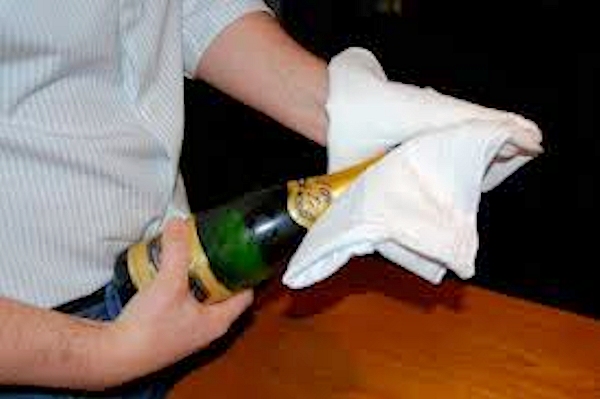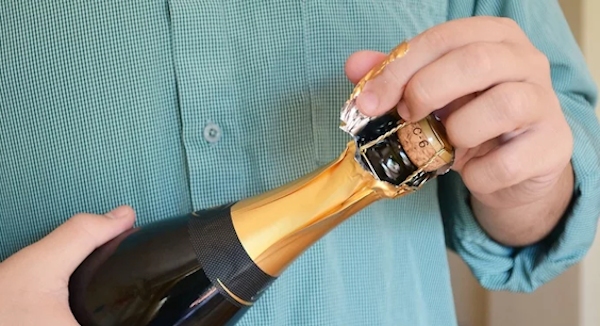Robert Bell's
Wines of Canada
Since 1992
How to Correctly Open Sparkling Wines
Step 1
Ensure the wine is correctly chilled to around 45 degrees Fahrenheit. If it isn't cold enough, the pressure inside the bottle will cause the cork to release very quickly. That's when you get a geyser and a dangerous projectile.
Step 2
Use a Wine Key to Cut off the Foil Below the Large Lip of the Bottle
Although all sparkling wines have a tab to help open the bottle, most of the time the tab fails to make its way around the bottle leaving an ugly mess of excess foil. Cutting the foil creates an even, clean line around the bottle so that once the foil is removed, the cork and cage are exposed.

Step 3
Fold a napkin or kitchen towel lengthwise and put it over the cage and the cork. This creates another measure safety that can help prevent the cork from flying off like a bullet.
Step 4
Untwist the cage counterclockwise, putting pressure on the cork to keep it from popping out prematurely.
It's best to hold the bottle at a 45-degree angle. Untwist the "O" six times and then loosen the cage all the way around the bottle.
Step 5
Twist the bottle—not the cork.
Once the cage is loosened, begin to extract the cork by keeping pressure around the cork and twisting the bottle. If you twist the cork, it can break inside the bottle.
Step 6
Once the bottle starts to loosen from the cork and is able to spin freely, begin to slowly pull the cork away from the bottle.
Do this until the pressure in the bottle begins to push the cork out naturally. Once you feel the cork begin to move on its own, push against the cork gentle to keep it from releasing too quickly.
Step 7
Now that the pressure of the bottle is driving the cork out, you can control how quickly the cork separates itself from the bottle.
The slower the cork separates itself from the bottle, the more gentle the hiss that will occur. People are always wowed when a bottle of sparkling wine is opened with barely a blip—aim for that.
Real Simple instructions
Follow These Steps
- Remove foil.
The foil on most bottles has a little tab that you can pull to make this process easier. If not, it’s a good idea to use a wine opener’s knife to begin this process. Once removed, discard the foil.- Loosen the wire cage.
Flip down the small wire “key” that’s pressed up against the neck of the bottle at the bottom of the wire cage that encloses the cork. Turn the key to loosen the cage. (Fun fact: all bottles of bubbly require exactly six half-twists to fully remove the cage). When finished, discard the cage.- Drape a towel over the bottle.
Now that the cork is exposed, drape a dish towel over the top of the bottle. This is used just in case built-up pressure causes the cork to pop on its own, but the towel will be at the ready to catch any wine spills, too.- Twist the bottom hand until the cork eases out.
Keeping the bottle pointed in a safe direction—away from you and other people—grasp the base of the bottle with your dominant hand and the cork the other. Do not try to twist the cork. Instead, hold the cork firmly while turning the bottle slowly toward you, with your hand holding the base. As you turn the bottle from the base, you should feel the cork start to loosen and then ease into your hand (slight hiss = success). Continue until you hear the soft pop of the cork leaving the bottle.
Pro Tip: To avoid foamy overflow, pour only about an inch of wine into each glass at first, wait a few seconds for bubbles to subside, and then continue filling to just below the rim.Corks from champagne or sparkling wine can erupt at speeds up to 60 mph. That is a lot of force to the eye. It can easy cause damage to light fixtures and other items in your home, be-careful. Don’t shake the bottle. Shaking increases the speed at which the cork leaves the bottle thereby increasing your chances of severe eye injury.
“When a champagne cork flies, you really have no time to react and protect your delicate eyes,” Dr. Monica L. Monica, an ophthalmologist and spokesperson for the American Academy of Ophthalmology, said in a statement. “Uncontrolled champagne corks can lead to painful eye injuries and devastating vision loss
I have seen some ladies become very upset when gushing wine has sprayed them damaging their favourite party dress.
Please see sparkling wine
Home | About | Sitemap | New Reports | Contact Us |©2020 Robert A Bell

